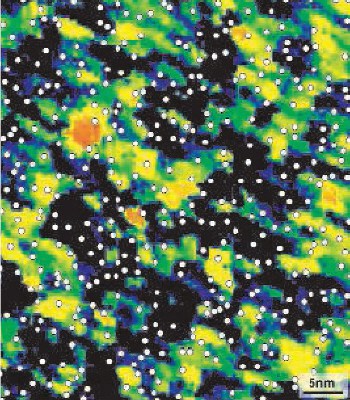Finding a theory that explains high-temperature superconductivity in cuprate materials is one of the outstanding challenges in condensed-matter physics. Now a team of physicists in the US and Japan has observed a new effect that could help in the search for such a theory. Cuprate materials are normally insulators but they become superconductors when dopant atoms are added. However, Seamus Davis of Cornell University and colleagues have found evidence which suggests that these dopant atoms can also lead to electronic disorder that damages the superconducting properties of the cuprates (Science 309 1048).

Doping generally involves adding impurities or charge carriers – which can be electrons or “holes” – to inert materials. The challenge is to produce the required electronic properties in the material with the dopant atoms, which are randomly distributed, without causing electronic disorder.
Davis and colleagues at Cornell, the University of California at Berkeley, the AIST laboratory in Tsukuba and the University of Tokyo studied crystals of bismuth strontium calcium copper oxide (Bi2Sr2CaCu2O8+x), also known as Bi-2212. This material is normally an insulator but it becomes a superconductor when extra oxygen atoms – which are a source of holes – are added. Superconductors lose their resistance to electric current when they are cooled below a transition temperature, Tc, that varies with the amount of doping. The basic phenomena underpinning superconductivity is the formation of Cooper pairs by the charge carriers.
Physicists have long suspected that dopant atoms lead to electronic disorder in Bi-2212 but there was no experimental evidence. Now Davis and co-workers have used a high-energy scanning tunnelling microscope (STM) to show that this disorder is caused by atomic-scale impurity states, and to show that it is highly likely that these impurity states are actually the dopant atoms. “If so,” says Davis, “the doping process, although necessary to create superconductivity, also damages it near the dopant atom. The way this damage is caused is also completely different to what we expected and to what happens in conventional superconductors.”
The results agree well with calculations performed by Peter Hirschfeld and colleagues at the University of Florida, which showed that the dopant atom distorts the “cage” of atoms around it and therefore changes the local electronic structure. Hirschfeld says that this could lead to an observable change in the local pairing interaction which, in turn, would lead to a change in the superconducting gap – the energy needed to break up the Cooper pairs.
Davis believes that better superconductors could be made by controlling the location of the dopant atoms. Indeed, two of his co-workers – Hiroshi Eisaki and Shin-ichi Uchida – have already increased the Tc of Bi-2212 to almost 100 Kelvin by minimising the disorder in the strontium-oxygen layer. This work could also help in the search to find a theory of high-temperature superconductors.
In conventional superconductors the formation of pairs and the onset of superconductivity are closely related. In the cuprates, on the other hand, they are quite independent. “The results in the Science paper gives us a hint about the mechanism responsible for the onset of superconductivity,” says Uchida. “They indicate the presence of a parameter – in addition to the doping concentration and independent of the pairing mechanism – that is sensitive to the disorder or small changes in the environment around the copper oxide plane on the atomic scale.”



